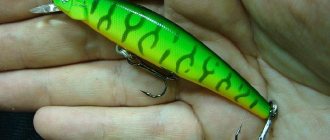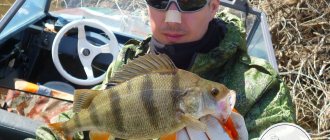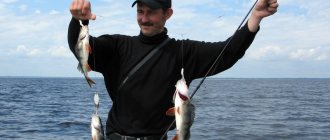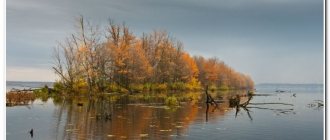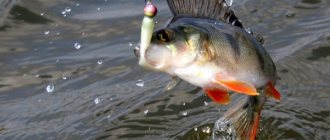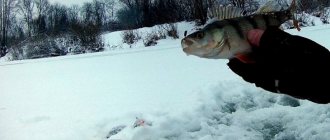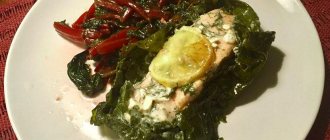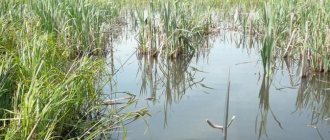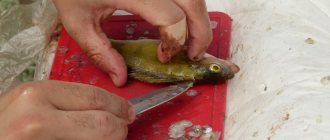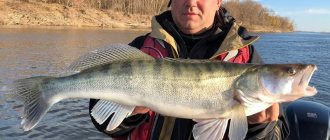What does red sea bass look like?
The appearance of sea bass varies depending on its habitat. Living at great depths, among larger predatory fish, it has poisonous spines on its fins, a laterally flattened body and bulging eyes.
The closer to the shore, the less uniform their coloring. In young fish, a pattern of stripes and spots is clearly visible, but with age it blurs. The length can reach a meter, although there are palm-sized representatives. Weight is 1−2 kg, but there are individuals reaching 10 kg.
What are those dark spots on the perch?
Dark spots may be part of its coloring or indicate illness. Only laboratory testing can determine their origin. The most unpleasant cause of spots is infection of the fish with a fluke worm.
This parasite is not dangerous for humans. If you notice the black-spotted color of a perch, you should protect yourself and heat-treat the carcass before consumption.
Bass fish: description
Trout perch has an elongated and compressed body on both sides, which tapers closer to the tail. The sides have a greenish tint with dark spots, which form a horizontal stripe that does not have perfectly even outlines. The fin, which is located on the back, is divided by a deep groove into two parts of equal length, and a small depression is visible on the tail.
The head of the fish is quite large in size, it has an impressive mouth that extends behind the eyes. Very small teeth are located in several rows on the palate and jaws. Largemouth bass have good eyesight. An adult bass can be up to one meter long and weigh more than 10 kg. Males are significantly smaller in size than females. The lifespan of this species is about 16 years.
Types of sea bass
Sea bass is of interest for both fishing and cooking. It is popular due to its excellent taste and is common in water bodies.
Northern sea bass
Representatives of northern sea bass are the largest, and their species is the most numerous. The body is firmly covered with hard scales of reddish shades. The lower part of the body may have dark spots. The danger comes from the poisonous spines on the dorsal fins and head.
They prefer to live individually or in small groups in hard-to-reach places, rocks and algae. The depth of their habitat is relatively shallow - about 300 m. They feed on sea reptiles and other inhabitants of the seabed.
Oriental
The body is about 30 cm, compressed at the sides. The ridges and spines are not developed. Jaw without scales. The tail fin is intact, without a notch. Eastern redfish are brownish-purple in color, becoming lighter towards the abdomen.
It lives mainly in shallows near the coast, hiding in sea grass, and less often in the mouths of reservoirs near the sea.
During daylight hours - in stones and rocks at a shallow depth of about 10 m; in the evening it subsides in algae. Young eastern perch can be found at a decent depth.
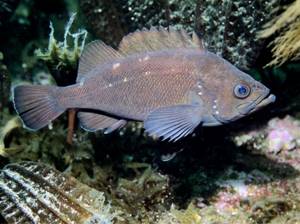
Terpug
Terpug is a schooling sea fish, a predator, part of the order of scorpionfish. Fresh fillets have an unusual yellow or green tint. The length of the fish reaches half a meter and weighs 1.5-2 kg, but there are also heavy representatives.
With a similar length, the weight can reach 60 kg. In some greenlings, the dorsal fin is completely solid, while in others it is dissected by a depression.
Aleutian
Aleutian perch looks scary:
- a massive fish with a large head studded with spines;
- the lower part of the eye has 2−10 sharp spines;
- the lower jaw is pushed forward, and there is a symphysial tubercle on it;
- the fin on the back has 13 hard and 13-14 soft rays;
- caudal fin with a notch.
The color of the perch is dirty red with black and gray fuzzy stripes on the head and the entire upper surface, the belly is light, there is a red line on the side, and the fins have a dark edging.
Black Sea
Black Sea perch goes by many other names. The original is spicara, another one is “smardina”, which comes from belonging to the smardinaceae family. He also received nicknames depending on his color and habits - “redfish”, “beaver” or blue perch.
Like previous species, it has a laterally compressed carcass, a solid dorsal fin with 10-12 spines, and an anal fin with three. The predator has many small teeth and even 2 protruding fangs from below. An interesting feature of the representatives is that their mouth extends into a tube. Black Sea perch on average lives up to 4-5, maximum 7 years.
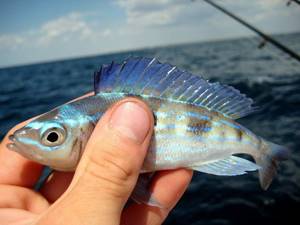
Stonefeather
The laterally flattened body is covered in small scales with teeth. Almost all fins and the body itself have spines:
- the fin on the back has hard and soft rays, about 30 of both in total;
- there are 3 spines on the anal fin, one spine each on the chest and abdomen;
- there are 3 spines on the gills.
Nature has provided that due to the variegated colors, the fish would be difficult to find among algae and stones. The brown body has vertical stripes on the sides, flowing through the tail into the dorsal fin. Because of them, the perch received the nickname “zebra”. The color range can range from blue to dark brown.
The head is decorated with dark red stripes, and the belly is bright blue in places. The fish has many sharp teeth and a large mouth. The size of the perch is about 25 cm; individuals of this species larger than 30 cm are considered giants.
White
Another name is Barramundi. It has a long body 1.5−1.7 m, weighs about 40 kg. When fishing, they usually come across about half a meter long and weighing a little more than 10 kg.
External features of white perch:
- the head is compressed from above;
- the jaw protrudes from below;
- high body;
- small anal fin.
A good catch of young fish can be obtained in late summer - early autumn. Found on the surface and at depth. Prized for its excellent taste.
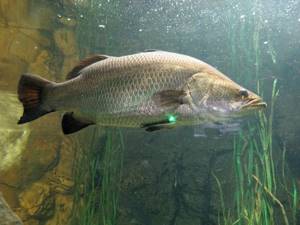
Black sea
It has an unusual olive-green coloration, sometimes with black spots forming a jagged line on the sides. It is considered the largest of all black perch representatives. Females are always larger than males. It chooses a habitat in calm, quiet water, where it can hide in the thickets and wait for prey.
From mid-spring, it goes to spawn for 4 months, which happens once a year. Males prepare a nest at the bottom, where the female can lay up to 80 thousand eggs, after which the male undertakes to guard them until the fry appear. Black sea bass live a long time - about 23 years.
Baikal
Lives mainly in Chivyrkuisky Bay. The size is average, about 25 cm, rarely found up to 40 cm. The body is cylindrical, the sides are flattened. He received the nickname “humpback” for the hunchback shape of his back. Spawns at a depth of 2 meters. The female lays up to 50 thousand eggs.
deep sea
Deep sea perch is also called Kinky. Lives in deep waters. The fins are equipped with poisonous spines. An injection with them provokes inflammation and threatens severe pain. This fish is colored bright red, may have stripes or spots on its body, and has large bulging eyes.
It reaches one meter in length and weighs about 18 kg. In their “appearance”, red perches are similar to river perches, but they differ greatly in body structure.
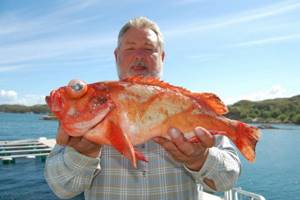
Pink
Pink, or American, perch are massive and covered with ctenoid scales. The body is compressed from the sides, the height of the body is 3 times in length. The maximum size is 30 cm. The head is large in relation to the body, the jaw is extended, and the symphyseal tubercle is located on the lower one.
The body and head are orange-red or pink. The belly is a little lighter. There are several greenish-black spots under the dorsal fin, and there are black spots on the posterior edge of the gill cover. All fins are red, the ventral and anal fins are more intensely colored.
The anal and dorsal fins are studded with spiny and soft rays, the caudal fin has a small notch.
The color of individuals is orange-red or salmon, the anal and ventral fins are brighter than the others. You can see a few greenish spots on the back, and black spots on the gills.
Oceanic
The giant oceanic grouper is the record holder for length and weight among its relatives. This is a fierce omnivorous predator. In the water column it is almost invisible due to its gray-brown color. Cases of attacks on humans have been recorded.
It is difficult to see the eyes on the giant's body. Prefers warm salty waters and places where it can camouflage itself in rocks, plants or sand.
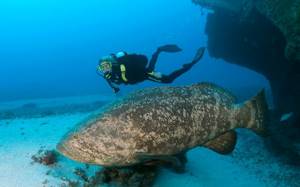
Dorado
Dorado belongs to the spar family, it is also called sea crucian carp. It chooses mainly tropical oceans and seas, where it feels best. It is also called “coryphaena” and is quite strange in appearance: it has a blunt head, a pronounced long fin and a tail clearly divided into 2 parts.
In some countries they are called dolphin fish, but are best known as dorado.
One of the features is a bright color, usually blue and green or yellow, but the brightness appears only during life; after death the paint fades.
Coryphaena is capable of migrating over very long distances, so it can be found all over the world in seas and oceans with tropical or temperate climates.
Black bass food and habitat
Like the common bass, the diet of black bass is very varied: black bass will eat almost everything, from small white fish, crayfish and aquatic larvae to frogs and even large insects that fall into the water.
He does not neglect the small waterfowl caught in the whirlpool.
In this regard, it should still be noted that such voracious trout perches are rather rare in Europe.
But numerous American studies indicate the gluttony of American black bass.
Black perch can lie in ambush in thick weeds or among sunken wood - from there they open an attack on schools of white fish. Very often in the shadow of water lilies you can see a motionless black perch.
In the river, black bass are found in oxbow lakes, upstream of the concrete dam and in very calm areas with a lot of vegetation or obstructions in the riverbed.
In stagnant bodies of water, perch likes to stay in the coastal zone, in shallow water or along the edges of a lake or pond, provided that there is enough vegetation there.
To locate fish, you should always have polarized glasses with you, which allow you to see through the water.
The most favorable time for fishing
Black perch are characterized by mood swings: they can remain in apathy for hours, and then develop feverish activity a minute later. The reasons for such sudden excitement are difficult to establish.
Perhaps the weather changed, a cloud covered the sun, it suddenly cleared up, or the wind blew strongly.
However, like all predatory fish, black bass are best caught at dawn, mid-day and evening twilight.
Winter is never a favorable time for fishing: black perch, accustomed to warm waters, does not tolerate the cold very well. It hides in deep cavities and rarely leaves them.
Does he bite at all in winter?
For a long time, experts answered this question in the negative, but some anglers still managed to get the usually large fish to bite.
Meanwhile, black bass were taking natural bait, metal bait and live bait using a sliding bobber.
Frogs and river crabs are top-notch bait
Rubber frogs with a movable head are used for fishing on the surface. When the line is pulled, the frog goes under the water, but as soon as the fish lets go of the bait, it immediately floats to the surface again.
Rubber crabs are good bait when they appear to be about to sink to the bottom.
Remember: drive backwards! At the same time, lower the bait in stages.
After touching the bottom, lift it a meter or two, and then with a sharp movement, pull it up and let it fall again.
The most favorable time of the year
It begins in mid-April, in more southern regions, where there is more sun, a little earlier.
Like all predatory fish, black perch is constantly hunting at this time, possibly replenishing its energy reserves.
It spawns in June and July. The male makes a nest in which the female lays eggs.
During the maturation period and later, that is, until the young fish become stronger, the male guards the nest, discourages uninvited guests, pushes oxygen to the eggs with the blows of his fins and introduces the young fish to the harsh laws of the fresh water body.
At this time, black bass are very aggressive. Fishing in such conditions means dooming subsequent fishing trips to failure!
Habitat
Widely distributed in the North Atlantic Ocean and the Arctic Ocean:
- western part of the Barents Sea until the 35th century. d., off Western Spitsbergen, Greenland Sea, Norwegian Sea, off the coast of northern Norway, around Iceland and the Faroe Islands;
- off the coast of eastern and western Greenland;
- off the east coast of Labrador and Baffin Island;
- Baffin Sea, Irminger Sea, Labrador Sea;
- south along the coast of North America to Cabot Sound and Long Island.
Where is it found?
Sea bass are found everywhere, but they have favorite places. Fishermen know that a good catch can be obtained in Norway. At a depth of 200-300 m you can even find rare red snapper. There are many of them in the Atlantic Ocean and the North Pacific Ocean.
This fish is much more comfortable in cold waters. Sometimes it can be found at a depth of 900 m. The fish migrates in schools in the Norwegian and Arctic Oceans.
Is it grown artificially?
If sea bass is found on the shelves, 90% of it is caught from natural bodies of water. This fish is not artificially grown. The Lavrak species of perch began to sharply decrease its population, so they were forced to adapt it and breed it artificially.
Unnatural living conditions always affect the quality of fish.
During this period of mid-summer, the perch begins to experience something like a glutton
It would seem that all other normal fish are in a kind of torpor during periods of summer heat, sometimes similar to suspended animation. And here the most active and fun time begins for the perch. But here everything is not so simple. This zhor is activated by perches of all sizes, colors and habitats, but fishing for all these different types of perches is completely different. And here we need to dwell in more detail on the types of perches, which, despite the fact that they live in the same forest lake, are completely different in habits, appearance, size and, as already mentioned, in fishing methods.

Let's start with the most common and abundant black bass, some of which even have a purple hue. These perches live or mostly stay under the low shores of the lake, where coolness and shade always reign. The lake water in some places goes under the shore about eight meters from the shore edge. This can be seen in the gaps between the roots of the trees and the turf, where the water turns black. Such a coastline with water under the shore, however, is quite strong, unless you fall through the hole between the roots. The bank rests on intertwined roots and turf, which is also tied together with strong grass.
Fishing for this black perch is very simple, and during the summer period it is often productive
Catching a bucket of perch in an hour is sometimes not difficult at all. Moreover, perches sometimes weigh up to three hundred grams. The fishing gear is also very simple. Usually we go to the moss swamp, which is nearby, and break or cut a very thin dry pine no more than two meters long. We attach a fishing line 0.18 mm thick to the tip, install a simple foam float and tie a light oatmeal jig. That's it... The tackle is ready. First, we attach a worm to the jig. After catching the first perch, we euthanize it and remove the eye. Now all fishing will take place only with the perch eye, which during this period the perch sometimes takes greedily and often. The fishing technique is also simple. A jig with an eye is thrown literally under your feet into the bays near the shore, preferably next to a tree lying in the water. The float floats a little along the float, something like wiring. And sometimes a bite follows immediately. If the school is large, then you can pull the perches one after another. When the perch stops taking, we move further along the shore to the next bay.
Another medium-sized perch, also dark, but already with some kind of yellowness, is sometimes desperately caught on the reaches of the lake and near the reeds using rotating spoons of the smallest sizes. Sometimes it takes better on small vibrating tails, rippers and twisters. But it quickly breaks the baits and tears off their tails. Therefore, “turntables” are more functional.
What does perch eat?
This is a predator. Its diet is based on small invertebrate organisms: mollusks and crustaceans. Thanks to its retractable mouth, it easily and quickly tears off soft tissues and mollusks that did not have time to react to the approach of a predator and did not close their shells.
Caviar and small fish also serve as food. Among plants it prefers algae.
The hunting pattern of sea bass is reminiscent of river bass. They quickly grab their prey and catch up with it.
Important! Large individuals prefer to hunt alone. To do this, they camouflage themselves, stopping near stones and hiding in water thickets.
Useful properties for humans
Perch meat is the most valuable fish product. More than one nation has appreciated its benefits. It contains many vitamins and elements essential for health: magnesium, sulfur, phosphorus, iodine, chromium, calcium, sodium, potassium, chlorine, iron, zinc, copper, manganese, fluorine, molybdenum, nickel.
The fish is rich in vitamins A, C, D, E, B, PP, contains polyunsaturated omega-3 fatty acids, taurine and easily digestible protein.
The calorie content of the product is quite low: 100 g of fresh fish contains 103 kcal, smoked - 88, boiled - 112, and fried - 137. This can also be said about the fat content. Atlantic perch contains 6%, and Pacific perch 3.3% fat, so the fish can be used in dietary nutrition.
Parasites in sea bass
Sea bass is susceptible to various types of parasites. For example, helminths are dangerous to humans, but there are also those that are harmful only to fish. Among them are the thin-bodied pharionis, as well as a white spherical pest.
You can tell that fish is contaminated by the stench. This smell can come from both a fresh carcass and when preparing broth. External signs of damage: distended peritoneum, dry mucous membranes, cloudy eyes, uneven skin, discolored gills.
Crustacean parasites
The most prominent representative of parasites under the skin in sea bass is Sphyrion lumpi. It affects both freshwater and sea bass. It appears under the skin of the fish, but sometimes half of the parasite’s body remains outside. In order to get rid of it, you should thoroughly heat treat the meat using salt and a sufficient amount of spices. A healthy fish should have a strong, elastic body with a good layer of fat. Often during the preparation of fish soup, dark pieces of parasites are observed floating on the surface.
